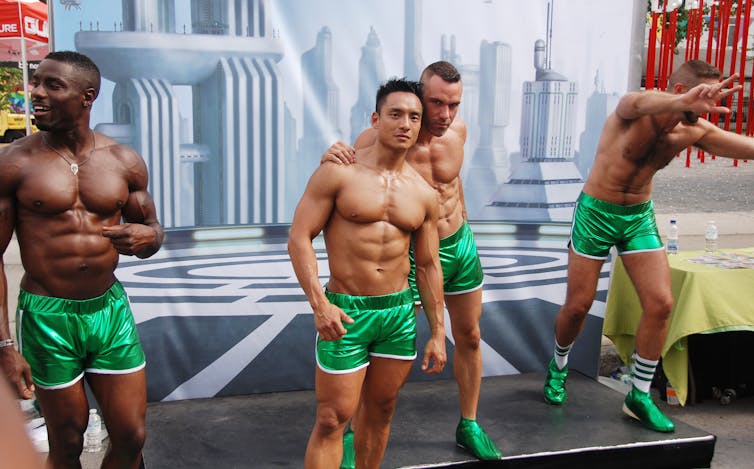
Adam Davies, University of Guelph and Rhea Ashley Hoskin, Queen's University, Ontario
This year, the 10-Year Challenge appeared as a social media fad on Instagram, Facebook and Twitter. For the challenge (also called the 2009 vs. 2019 Challenge), people post two side-by-side photos of themselves to show how much they’ve changed: one photo is current and the other from 10 years ago.
The opportunity to self-reflect on a decade’s worth of changes can be a wonderful opportunity to assess one’s development. This may be especially true for queer and trans people who may have significant changes to share as they become more open about their identity.
But for others, the posts may feel less celebratory. They may even feel self-denigrating.
Many gay men describe their 2009 picture as “gross,” “unattractive” or “grotesque” in ways that link these qualities to femininity. These attitudes are consistent with societal messages that men should not express femininity.
As we scroll through these posts, especially by gay men, we believe many sentiments expressed reveal a deep femmephobia within LGBTQ+ communities. They also echo widespread issues of body dysmorphia (the obsessive feeling that a part of your body is flawed) and include fat-shaming or inadvertently praise disordered eating.
The posts raise alarms for us because we believe they are part of a growing culture of gay men glorifying femmephobia and elements of toxic masculinity.
Dating apps: hotbeds of body image struggles
Within our research, we seek to understand and illuminate femmephobic attitudes. For many gay men, Facebook and Instagram and gay-specific dating apps are hotbeds of body image struggles and online gender-based discrimination.
Research suggests that this phenomenon is linked to gay men’s tendency to openly discriminate against other gay men who express a gender outside of traditional masculinity. Gay men’s skinny and thin bodies are viewed with disgust by other men seeking more “masculine” presenting partners.
On dating apps like Grindr, there is the ubiquitous hateful saying: “No fats, no fems, no Asians”. This saying is reflective of the systemic denigration and discrimination against feminine gay men — both fat and thin male bodies — as well as Asian men.
Asian men have historically been stereotyped as passive, submissive and failing expectations for masculinity, with gay Asian men experiencing high amounts of femmephobia and gender-based stereotyping within gay men’s communities.
Scruff, a gay hook-up app is a prime example of the privilege masculinity receives in gay men’s communities. Scruff is marketed and catered to a “scruffy” demographic. Scruffy or rugged men who have hair on their bodies and large amounts of facial hair can congregate online, commonly leaving those considered more feminine ostracized from such spaces.
Likewise, Grindr, the most popular gay hook-up app, is well-known for its focus on fit bodies, muscular physiques and gym selfies.
In this pursuit, researchers have shown gay men to have high levels of body dysmorphia, which can result in a preoccupation with gym culture, or taking silicon implements and testosterone enhancers to grow muscle mass.
Gay men interact with one another online in heavily masculinized ways, with a focus on short sentences, quick phrases and highly sexualized text. They tend to avoid emotional expressions and committed relationships.
Twinks
Some researchers suggest that gay men commonly express femininity during adolescence, yet this is diminished to conform to masculine ideologies as adults. An especially influential example of this in the gay subculture is “twinks,” a common term to describe young, effeminate, typically white and slender gay men.

Although twinks are highly valorized by certain segments of the gay community for their youthfulness, they are also often negatively stereotyped. They deal with perceptions of frivolity, passivity and superficiality. and are fetishized or objectified as play-things that simultaneously affirms the masculinity of other men.
Young twinks are encouraged to either masculinize their gender expression or become submissive for the consumption of more masculine gay men.
Within twink communities are high rates of sexual assault experiences and high suicide rates.
Toxic masculinity
An especially influential study by clinical psychologist Kittiwut Jod Taywaditep found many gay men endorse femmephobic sentiments and engage in a processes of “defeminization” between adolescence and adulthood.
For many gay men, growing out of their femininity is seen as a sign of adulthood — an evolution of the body and self as they shed their former feminine and boyish self and enter adulthood as a stable and masculine man who has internalized dominant notions of masculinity.
With femininity’s associations with youthfulness and incompletion, masculinity is secured as a cultural symbol of adulthood. This adulthood is then associated with a masculine and athletic body. This evolution narrative crafts a spectrum of gender expression that places femininity on the left and masculinity on the right.
It creates an ideology that views feminine men as inferior or “not fully developed.”
Comments on these posts on social media about body size and youthful appearance bolster the narrative of femininity as inferior and infantile.
The narrative of the 10-Year Challenge seems to be that all is OK once a femme defeminizes and grows into a respectable masculine man. These attitudes towards the “femmes of 2009” need to stop to avoid solidifying toxic masculinity in LGBTQ+ communities.
Adam Davies, Assistant Professor, University of Guelph and Rhea Ashley Hoskin, Postdoctoral Researcher in Femininities, Femme and Femmephobia, Queen's University, Ontario
This article is republished from The Conversation under a Creative Commons license. Read the original article.

